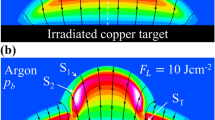Abstract
This paper is devoted to the improvement of a numerical Maxwell-Schrödinger system, modeling the intense, high frequency and ultrashort laser-gas interaction and propagation, and previously presented in [3]. To this original model is added an equation of evolution of the free electron density, allowing then to describe precisely the current density in the Maxwell equations. Free electrons are obtained by absorption of the wavefunctions at the boundary of their corresponding TDSE computational domain. As a consequence higher intensity and longer pulses can then be considered using this new model compared to [3]. The new computing strategy is then presented, following [4].
Access this chapter
Tax calculation will be finalised at checkout
Purchases are for personal use only
Preview
Unable to display preview. Download preview PDF.
Similar content being viewed by others
References
Brabec, T., Krausz, F.: Intense Few Cycle Light Pulses. Rev. Mod. Phys. 72, 545–591 (2000)
Bandrauk, A.D., Barmaki, S., Kamta, G.L.: Molecular High Order Harmonic Generation. In: Yamanouchi, K. (ed.) Progress in Ultrafast Intense Laser Science, ch. 9, vol. III. Springer, NY (2008)
Lorin, E., Chelikowski, S., Bandrauk, A.: Numerical Maxwell-Schrödinger model for laser-molecule interaction and propagation. Comput. Phys. Comm. 177(12), 908–932 (2007)
Lorin, E., Bandrauk, A.: Numerical Maxwell-Schrödinger model for laser-molecule interaction and propagation. In: IEEE Proc. HPCS 2008, pp. 4–8 (2008)
Lorin, E., Chelikowski, S., Bandrauk, A.: Numerical Maxwell-Schrödinger model for laser-molecule interaction and propagation. Num. Meth. for Partial Differential Equations 25(1), 110–136 (2009)
Couairon, A., Mysyrowicz, A.: Organizing multiple femtosecond filaments in air. Phys. Report. 41(3), 47–189 (2007)
Bergé, L., Skupin, S., Nuter, R., Kasparian, J., Wolf, J.-P.: Ultrashort filaments of light in weakly ionized, optically transparent media. Reports on Progress in Physics 70(10), 1633–1713 (2007)
Antoine, X., Arnold, A., Besse, C., Ehrhardt, M., Schädle, A.: A review of transparent and artificial boundary conditions techniques for linear and nonlinear Schrödinger equations. Comm. Comput. Phys. 4(4), 729–796 (2008)
Corkum, P., Krausz, F.: Attosecond Science. Nature Phys. 3, 381–387 (2007)
Author information
Authors and Affiliations
Editor information
Editors and Affiliations
Rights and permissions
Copyright information
© 2010 Springer-Verlag Berlin Heidelberg
About this paper
Cite this paper
Lorin, E., Bandrauk, A.D. (2010). A Maxwell-Schrödinger-Plasma Model and Computing Aspects for Intense, High Frequency and Ultrashort Laser-Gas Interaction. In: Mewhort, D.J.K., Cann, N.M., Slater, G.W., Naughton, T.J. (eds) High Performance Computing Systems and Applications. HPCS 2009. Lecture Notes in Computer Science, vol 5976. Springer, Berlin, Heidelberg. https://doi.org/10.1007/978-3-642-12659-8_6
Download citation
DOI: https://doi.org/10.1007/978-3-642-12659-8_6
Publisher Name: Springer, Berlin, Heidelberg
Print ISBN: 978-3-642-12658-1
Online ISBN: 978-3-642-12659-8
eBook Packages: Computer ScienceComputer Science (R0)




